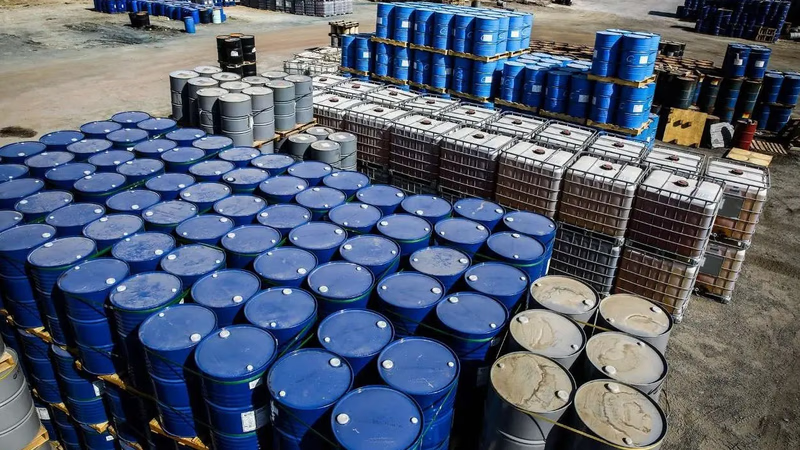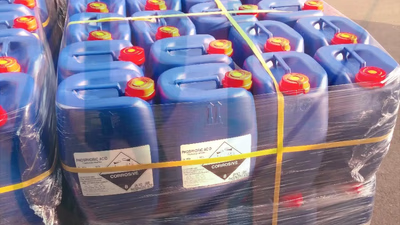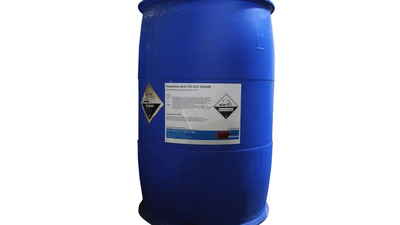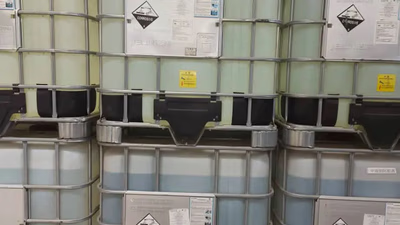
Phosphoric Acid: Essential for agriculture and food industries.
Phosphoric acid, also known as orthophosphoric acid, is a mineral acid with the chemical formula H₃PO₄. It is a clear, colorless liquid with a syrupy consistency and a strong, tangy taste. Phosphoric acid is produced by either the wet process or the thermal process. In the wet process, phosphate rock is first reacted with sulfuric acid to produce phosphoric acid. This process involves the extraction of phosphate from the rock, which is then reacted with sulfuric acid to form a mixture of phosphoric acid and calcium sulfate. The mixture is filtered, and the phosphoric acid is further purified and concentrated.
Phosphoric acid is a triprotic acid, meaning it can donate three protons (H⁺ ions) in solution. Its chemical formula, H₃PO₄, indicates the presence of three hydrogen atoms, one phosphorus atom, and four oxygen atoms. The acid dissociates in water to release these protons, making it an acidic solution. Phosphoric acid is considered a moderately strong acid. Its acidity is often expressed using the pH scale, which ranges from 0 to 14. Phosphoric acid has a pH of around 2.2, making it highly acidic. However, the pH can vary depending on the concentration and temperature of the solution.
Phosphoric acid, or orthophosphoric acid, is a triprotic acid that is a dense liquid. This acid corrodes and irritates the human mucous membranes, skin and eyes. It is a colorless, odorless, clear liquid that releases flammable hydrogen gas when it comes in contact with metals. Pure phosphoric acid is white solid crystals with a melting point of 42.35 ° C. This acid is boiled at 158 ° C and its components are separated. When phosphoric acid is less concentrated, it is colorless, odorless, and a viscous liquid with a density of 1,685 g / ml (room temperature).
However, this density when solid is equal to 2.03 g / ml. This acid is non-toxic and unflammable. The highest common concentration of phosphoric acid in water is 85% and the lowest for sale is 50%. This acid is best stored at a temperature below 30 ° C. At temperatures below 20 degrees, this acid becomes a very cold liquid and in many cases will not freeze. It's important to handle phosphoric acid with care as it is corrosive and can cause burns. When diluted, it is generally safe for consumption in food and beverages within regulatory limits.
Phosphoric acid is any chemical that is made up of a combination of the three elements i.e. phosphorus, oxygen, and hydrogen (in various proportions). The most common type of phosphoric acid is orthophosphoric acid with the chemical compound H3PO4, commonly known as simple phosphoric acid. This acid is arguably one of the most widely used acids in the food, cosmetics, pharmaceutical and especially agricultural industries. Therefore, being familiar with its history, properties and applications in particular will be essential for technicians and enthusiasts.
Phosphoric acid is widely used in the food and beverage industry. It is a common ingredient in carbonated soft drinks, providing a tangy flavor and acting as a pH adjuster. It also functions as a preservative, preventing the growth of bacteria and molds. Additionally, phosphoric acid is used in the production of jams, jellies, processed meats, and cheeses. One of the major applications of phosphoric acid is in the manufacturing of fertilizers. It is an essential component in the production of phosphate-based fertilizers like DAP and MAP. These fertilizers provide plants with phosphorus, an essential nutrient for their growth and development.
Phosphoric acid finds use in various industrial processes. It is employed in metal surface treatment, such as rust removal and acid cleaning of metal surfaces. The acid's corrosive properties make it effective in dissolving and removing mineral deposits and rust. Phosphoric acid is also utilized in the synthesis of pharmaceuticals, detergents, water treatment chemicals, and flame retardants. While phosphoric acid is generally safe when properly handled and used in accordance with regulations, it is important to exercise caution. Concentrated phosphoric acid can cause severe burns and eye damage. Proper protective equipment, such as gloves and goggles, should be used when handling it. Additionally, it should be stored and transported in appropriate containers to prevent leaks and spills.
In the thermal process, phosphorus is burned in an excess of air to produce phosphorus pentoxide (P₂O₅). The phosphorus pentoxide is then dissolved in water to form phosphoric acid. Phosphoric acid is widely used in various industries and applications. It is commonly used as a food additive, particularly as an acidifying agent, flavor enhancer, and pH adjuster in soft drinks and other beverages. It is also used in the production of fertilizers, detergents, metal surface treatment, pharmaceuticals, and other chemicals. Phosphoric acid is a key ingredient in the manufacturing of phosphate-based fertilizers, such as diammonium phosphate (DAP) and monoammonium phosphate (MAP).
-

Phosphoric acid, or orthophosphoric acid, is a mineral acid with the formula H₃PO₄. It is produced through either the wet or thermal process. The wet process involves reacting phosphate rock with sulfuric acid, resulting in a mixture that is filtered and purified to yield phosphoric acid. This triprotic acid has a pH of around 2. 2, indicating its strong acidity. Phosphoric acid is widely used in various industries, particularly in food and beverages as a flavor enhancer and preservative. It plays a crucial role in the production of phosphate-based fertilizers like DAP and MAP, essential for plant growth. Additionally, it is utilized in metal surface treatment and the synthesis of pharmaceuticals and detergents.
While generally safe when handled properly, concentrated phosphoric acid can cause burns and eye damage; thus, protective equipment is necessary during handling. Its applications extend across agriculture, food processing, cosmetics, and industrial processes.
-

Phosphoric acid is a versatile compound utilized across various industries due to its ability to adjust pH levels. In the food and beverage sector, it serves as an acidulant and flavor enhancer, commonly found in carbonated drinks and processed foods. Its role in agriculture is significant, as it is a key ingredient in phosphate-based fertilizers that promote plant growth by replenishing soil phosphorus. Additionally, phosphoric acid aids in water treatment by controlling alkalinity and preventing scale formation in cooling towers and boilers. It also finds applications in chemical manufacturing, where it acts as a reactant or catalyst for producing phosphate salts used in detergents and pharmaceuticals. The cleaning properties of phosphoric acid make it effective for rust removal and metal surface preparation. Overall, its diverse applications highlight its importance in enhancing product quality and supporting various industrial processes.
-

West Asia, particularly Saudi Arabia, Jordan, and Morocco, is a significant player in the phosphoric acid market due to its abundant phosphate rock reserves. These countries are major producers and exporters of phosphate-based fertilizers, which utilize phosphoric acid as a key ingredient. The region"s strategic location and access to resources have fostered growth in the phosphoric acid sector. Beyond fertilizers, phosphoric acid is utilized in various industries such as chemicals, food and beverages, and metal treatment. The increasing industrialization in West Asia has heightened demand for this versatile compound. Despite being a major exporter, the Middle East also imports phosphoric acid to meet local needs due to lower production levels. Investments in new production facilities are underway but will not be operational until after 2025. For instance, the National Iranian Copper Industrial Company plans to invest 250 million euros into developing phosphoric acid plants that will require substantial phosphate soil imports annually.
The market is expected to grow driven by population increases and rising food demands while facing challenges from price fluctuations and environmental regulations. Overall, the region"s investments in infrastructure and production capabilities position it competitively within the global phosphoric acid market.
-

Phosphoric acid production primarily utilizes the wet process, where phosphate rock is mined, ground, and reacted with sulfuric acid to yield phosphoric acid and calcium sulfate. This method is favored for its lower energy requirements and higher purity of the final product. The wet process involves filtering the mixture to separate solid calcium sulfate from liquid phosphoric acid, which is then concentrated through evaporation. An alternative method, the thermal process, involves burning elemental phosphorus to produce phosphorus pentoxide, which is then dissolved in water to form phosphoric acid. While both methods have their pros and cons, the wet process remains dominant due to its efficiency. Environmental sustainability is becoming a key focus in production practices, with efforts aimed at reducing waste and minimizing ecological impacts. Historical context reveals that phosphoric acid has been recognized for its agricultural benefits since the 19th century, leading to its widespread use as a fertilizer. As industries evolve, sourcing reliable phosphate mineral ores has become essential due to past challenges with bone prices.
-

Phosphoric acid, derived from phosphorus, has a rich history dating back to the late 17th century when Hennig Brand first isolated phosphorus. The understanding of phosphoric acid evolved significantly in the early 19th century through the work of chemists like Jöns Jacob Berzelius. Initially produced via the bone-ash process, which treated bones with sulfuric acid, commercial production began in the mid-19th century. The wet process emerged in the early 20th century, replacing the bone-ash method due to its efficiency. The molecular structure of phosphoric acid (H₃PO₄) was elucidated in the late 19th century, leading to its widespread use in agriculture as a fertilizer and in various industries such as detergents and food production. Phosphoric acid became essential for enhancing crop yields and was later recognized for its role as an acidulant in beverages. Regulatory bodies have since established safety standards for its use in food products. However, environmental concerns regarding phosphate mining and processing have prompted efforts to improve sustainability within the industry.





